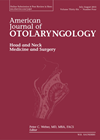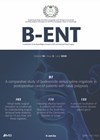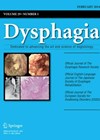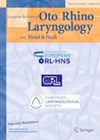Storytelling is good for your memory
Mild cognitive impairment (MCI) presents a challenging frontier in healthcare due to the limited availability of effective drugs. Despite its prevalence and potential progression to dementia, there remains a notable gap in pharmacological interventions targeting MCI. This month’s Editors’ Choice...
Chronic rhinosinusitis – a pre-malignant condition?
Nasopharyngeal carcinoma (NPC) is a relatively uncommon diagnosis in the West but is prevalent in Southeast Asia. Several factors have been established to be associated with a higher risk of developing NPC, including salted fish consumption, smoking, alcohol, and Epstein...
Long-term results for dupilumab are very promising!
Eosinophilic chronic rhinosinusitis (eCRS) is complicated by frequent early and aggressive recurrence of polyps after both medical and surgical treatment regimes. Dupilumab is an anti-IL-4/IL-3 receptor monoclonal antibody and has been previously studied in the SINUS-52 study, with an observation...
Is GERD linked to CRS?
We are all well aware that both chronic rhinosinusitis and reflux are prevalent in our populations. This meta-analysis looked at 25 studies investigating the association between GERD, LPR and CRS, therefore evaluating more than 117,000 patients. The results are fascinating...
THRIVE: redefining airway management in endoscopic oesophageal surgery
Transnasal humidified rapid insufflation ventilatory exchange (THRIVE) is no longer just a tool to help anaesthetists secure a difficult airway. Thanks to the work of authors like Yang and colleagues, it is being revolutionised to provide apnoeic oxygenation during endoscopic...
Vascular disease and sudden sensorineural hearing loss
Oussoren et al performed a systematic review and meta-analyses of current literature on the above topic: specifically, cardiovascular risk factors for developing idiopathic sudden sensorineural hearing loss (iSSNHL), the presence of white matter hyperintensities in patients with iSSNHL and the...
Septal perforation healing
This Turkish animal-based study looked at the healing properties of Hypericum Oleum (HO, or St John’s wort) and Triticum vulgare (TV, or wheat germ oil) on nasal septal perforations in rats. Both HO and TV have wound healing properties and...
COVID-19 and dysphagia in critically ill patients: a reflection of some findings
Dysphagia was a common occurrence in patients admitted to intensive care units (ITU) during the pandemic. This paper explores data from 26 ITUs over 12 months during 2020-2021. Findings from 235 patients admitted with Delta and subsequent Covid variants who...
Vestibular function preservation after minimally invasive paediatric cochlear implantation
This retrospective study analysed results in 24 paediatric patients with low-frequency residual hearing before and after minimally invasive cochlear implantation. The authors define minimally invasive cochlear implantation as a round window insertion of flexible Nucleus CI422, Nucleus CI522, MedEl Flex...
ChatGPT to select patients for biologic therapies in CRSwNP?
This short communication describes programming the artificial intelligence (AI) algorithm for systematic review of current literature about guidelines on the clinical efficacy and safety of biologics in the treatment of chronic rhinosinusitis with nasal polyps (CRSwNP). The authors first performed...
Use it or lose it…
The ageing auditory system: about 15 years ago, you could probably count on one hand the number of research papers on this subject. Now it seems one of the hot topics of discussion and investigation. This is, it seems, quite...
Higher risk and a tailored need
Historically, in audiology there is almost an unspoken understanding that when presented with a musician, a nuanced approach is likely to be required. Previous research has already shown there is a higher risk of noise exposure and accompanying signal distortion...
















